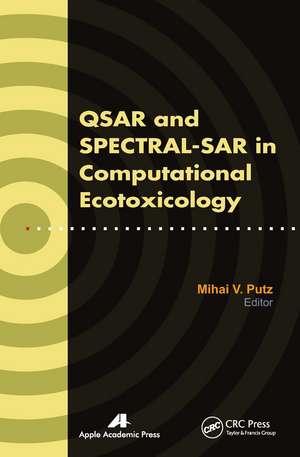QSAR and SPECTRAL-SAR in Computational Ecotoxicology
Editat de Mihai V. Putzen Limba Engleză Paperback – 31 mar 2021
The book covers:
- The classic QSAR approach
- The new SPECTRAL-SAR approach
- How to draw SPECTRAL-SAR maps for predicting ecotoxicological mechanisms for a given series of toxicants and single or multi-species in an open system
- Biological activity as related to chemical reactivity through associate descriptors
This book will be very useful in advanced courses on computational ecotoxicology, drug design and interaction, methods in quantum and computational chemistry, chemical molding, chemical bonding, and others.
Preț: 579.62 lei
Preț vechi: 681.91 lei
-15% Nou
Puncte Express: 869
Preț estimativ în valută:
110.95€ • 120.55$ • 93.25£
110.95€ • 120.55$ • 93.25£
Carte tipărită la comandă
Livrare economică 21 aprilie-05 mai
Preluare comenzi: 021 569.72.76
Specificații
ISBN-13: 9781774632024
ISBN-10: 1774632020
Pagini: 242
Dimensiuni: 156 x 234 x 13 mm
Greutate: 0.45 kg
Ediția:1
Editura: Apple Academic Press Inc.
Colecția Apple Academic Press
ISBN-10: 1774632020
Pagini: 242
Dimensiuni: 156 x 234 x 13 mm
Greutate: 0.45 kg
Ediția:1
Editura: Apple Academic Press Inc.
Colecția Apple Academic Press
Public țintă
Academic and PostgraduateCuprins
SPECTRAL-SAR Algorithm and the Algebraic Correlation Factor. SPECTRAL-SAR Assesment on Ionic Liquids’ Toxicity. Quantum and Statistical Interpretation of SPECTRAL-SAR Method.
Notă biografică
Mihai V. Putz is a laureate in physics (1997), with an MS degree in spectroscopy (1999), and PhD degree in chemistry (2002), with many post doctorate stages: in chemistry (2002-2003) and in physics (2004, 2010, 2011) at the University of Calabria, Italy, and Free University of Berlin, Germany, respectively. He is currently Associate Professor of theoretical and computational physical chemistry at West University of Timisoara, Romania. He has made valuable contributions in computational, quantum, and physical chemistry through seminal works that appeared in many international journals. He is actively promoting a new method of defining electronegativity, DFE (Density Functional Electronegativity), among new enzyme kinetics (Logistic Enzyme Kinetics), and of new structure-activity relationship (SPECTRAL-SAR) model for a unitary quantum approach of the chemical reactivity targeting the bio-, pharmaco-and ecological analytical description.
Recently, he is Editor-in-Chief of the International Journal of Chemical Modelling and the International Journal of Environmental Sciences. He is member of many professional societies and has received several national and international awards from Romanian National Authority of Scientific Research (2008), the German Academic Exchange Service DAAD (2000, 2004, 2011) and the Center of International Cooperation of Free University Berlin (2010). He is the leader of the Laboratory of Computational and Structural Physical Chemistry at Chemistry Department of West University of Timisoara, Romania, where he conducts research in the fields of quantum chemistry and quantitative-structure activity relationships (QSAR). In 2010 Mihai V. Putz was declared through a national competition the Best Researcher of Romania.
Recently, he is Editor-in-Chief of the International Journal of Chemical Modelling and the International Journal of Environmental Sciences. He is member of many professional societies and has received several national and international awards from Romanian National Authority of Scientific Research (2008), the German Academic Exchange Service DAAD (2000, 2004, 2011) and the Center of International Cooperation of Free University Berlin (2010). He is the leader of the Laboratory of Computational and Structural Physical Chemistry at Chemistry Department of West University of Timisoara, Romania, where he conducts research in the fields of quantum chemistry and quantitative-structure activity relationships (QSAR). In 2010 Mihai V. Putz was declared through a national competition the Best Researcher of Romania.
Recenzii
”This monograph gathers, through a collection of original papers, the methodology and implementation of the newly QSAR method, built on algebraic means--the SPECTRAL-SAR, with toxicological applications for paradigmatic classes (including ionic liquids) of molecules and aquatic species. The book responds to the currents needs for in silico assessment of the mechanistic interpretation of the ligand-receptor interactions in open systems, especially where statistical analysis provides limited interpretation of the results. Overall, the volume may be regarded as a collection of advanced chapters in computational ecotoxicology equally valuable for graduate students and researchers working in the field of environmental sciences.”
--Prof. dr. Vasile Chis, Faculty of Physics, Babes-Bolyai University, Romania
“This innovative and well-written book, edited by Prof. Putz, largely expands the OECD QSAR Toolbox available online by introducing new powerful concepts, like the minimum spectral path principle, and new correlation factors to measure chemical–biological interactions. These algorithms constitute the SPECTRAL-SAR approach and achieve ‘spectacular computational results’ in all the studies presented in the book. The book is instrumental for university and chemical industry researchers in their daily jobs in filling gaps in ecotoxicity data needed for assessing the hazards of chemicals.”
--Dr. Ottorino Ori, Actinium Chemical Research, Rome, Italy
--Prof. dr. Vasile Chis, Faculty of Physics, Babes-Bolyai University, Romania
“This innovative and well-written book, edited by Prof. Putz, largely expands the OECD QSAR Toolbox available online by introducing new powerful concepts, like the minimum spectral path principle, and new correlation factors to measure chemical–biological interactions. These algorithms constitute the SPECTRAL-SAR approach and achieve ‘spectacular computational results’ in all the studies presented in the book. The book is instrumental for university and chemical industry researchers in their daily jobs in filling gaps in ecotoxicity data needed for assessing the hazards of chemicals.”
--Dr. Ottorino Ori, Actinium Chemical Research, Rome, Italy
Descriere
This book presents a collection of studies based on the epistemological bulk data-information-knowledge of the chemicals used in green chemistry. It assesses a specific model of pattern characterization of concerned active substances at the bio-, eco- and pharmacologic levels through unitary formulation of the effector-receptor binding degree po
